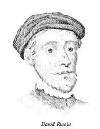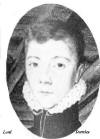|
The murders of David Riccio
and Henry Stuart, Lord Darnley
David Riccio was born about
1534 in Pancalieri in Piedmont, Italy. His first
employment was with Archbishop of Turin and later he was
a protege of the Marquis de Morette, the Ambassador of
Savoy. In December 1561 the Ambassador brought
Riccio to Scotland as a secretary. He was an excellent interpreter speaking fluent French as well as Italian, and something of a musician. He was soon entered and something of a musician. He was soon entered
into Court life as a `varlet` or `chalmer -cheild` –
a valet of the Queen`s chamber. He was paid £80 a
year but received many additional payments for clothing, furniture and furnishings. As his role increased so did the disbursements made to him such that he was soon better dressed and accoutred than the King (Darnley). As his wealth and status increased so did his vanity and the number of enemies he made. Although he never achieved the position of Chancellor, he was provided by the Queen, with a replica of Darnley`s seal which he used to seal declarations and other papers that the King routinely signed. This would have included endorsing Acts of Parliament.
In 1564 he was
appointed French Secretary to the Queen, by which time he
was deeply involved with intrigues and self betterment
with ancillary payments often made for such as furniture
and clothes. A French priest, John Daniot, is said to have warned Riccio to make his fortune and be gone. But Riccio`s response showed how little he knew of the Scots character saying ” the Scots would bragg but not fight.” He was similarly denigrating about the Earl of Murray whom he said “That the bastard should never live in Scotland in his time”. Ironically it was the bastard son of the Earl of Angus, George Dowglas (Douglas) who delivered the first stab in his murder.
John Knox described Riccuio as
“that great abusar of this
commoun wealth, that pultron and vyle knave Davie, was
justly punished, the nynt of March , in the year of God Jm
Vc threescore five (1565).”
The English Ambassador wrote in a letter of 3 June 1565
“David now worketh all, and
is only governor to the King and his family; great is his
pride, and his words intollerable. People have small joy
in this new master, and find nothing but that God
must either send him a short end, or them a miserable
life. The dangers to those that he hateth are great, and
either he must be taken away, or they find some
support, that what he intendeth to others may fall
upon his self.”
Rizzio was suspected by many
courtiers as being a papist spy and this may have been an
additional reason for his murder. Another reason offered was that he sought to influence the Queen to proceed against the Earl of Murray and the chief Protestants. He was certainly engaged
in feathering his own nest and Knox wrote that he (Riccio)
“was so foolish, that not only
he had drawn unto him the managing of all affaires, the
King set aside, but also his equipage and train did
surpass the King`s; and at the Parliament that was to be ,
he was ordained to be Chancellour; which made the Lords
conspire against him:
He was also allegedly a
handsome ladies` man, so an element of jealousy by Darnley
cannot be ruled out. But politics and `pay back` time arrived on 9 March 1565/6 when a group of nobles led by
the Earl of Morton, Lord Ruthven and
 Lord Lord
Lindsay, entered the Queen`s private chambers and seized
Rizzio; he was stabbed between fifty and sixty times (fifty three according to Knox`s History) before
being thrown down the stairs.
Mary was disgusted with Darnley and his involvement in the
murder of
Rizzio and she soon fell in with the blandishments of
James Hepburn, 4th Earl of Bothwell (1536-1578).
Bothwell had been at Court when Rizzio was murdered
but did not intercede; he climbed out of a window and
galloped pell mell
to safety in his
castle at Dunbar.
There was already a coldness in the relationship of the Queen and Darnley which now turned to dislike, if not hatred. Darnley continued in his feckless ways, drinking and horse racing with his cronies and was more often in Stirling than with the Court. The Queen was accompanied now by Bothwell. There had been an earlier
attempt in 1566 on Darnley`s life when at Stirling he was
poisoned. Darnley had just left the city to go to his
father`s home near Glasgow, when he collapsed in pain.
Arriving at Glasgow the physicians saw `blisters breae
out, of a blewish colour` and recognised poisoning. There
was fear for his life but Darnley managed to pull through
mainly because of having a strong and youthful physique. In a very short space of time Darnley and Mary became disaffected; he spent more time away from Court than at it, and was often at Stirling. Mary declined to grant him his own Coat of Arms designating him with the Crown Matrimonial, and she turned more and more to Riccio for companionship. In the background loomed the Earl of Bothwell soon to displace Darnley in Mary`s affections.
A new, and fatal, twist in the
saga of Darnley then took place.
 In In
the early hours of the morning of 10 February 1567 an
explosion rent the air of Edinburgh. Darnley was found in
his nightclothes in the garden but without any signs of
burning or the blast; he appeared to have been strangled.
Nearby was the body of a servant. A version of the story
goes that Darnley had heard some noise in the apartment
below his and had himself lowered from his room in a chair
suspended on ropes. On gaining the ground he ran into the
conspirators who did their murderous deed.
Those involved in the killing of Darley, under direction
from Bothwell, were Sir James Balfour, Gilbert Balfour,
David Chalmers, black John Spense, Francis, Sebastien,
John of Bourdeaux and Joseph, the brother of David Rizzio.
Incriminating evidence was found in the garden of a dress slipper or shoe, called a `mullis` which was identified by a cordiner (shoemaker ) in the Canongate as one he had made for Maitland of Lethington, thus implicating him in the murder.
John Knox wrote in his
History of the Reformation that
“The reason why the King`s
death was so hastened, because the affection or passion of
the Earl of Bothwell could not bear so long a delay, as
the procurement of a bill of divorce required.”
In the notes to Biographia
Scoticana, called The Judgement and Justice of God
Exemplified, Howie refers to Darnley thus:
..
the queen decoyed him to Edinburgh; where she and Bothwel
laid a plan for his life where in Bothwel was to be the
aggressor. In prosecution of which, he with some others
entered the king’s lodgings in the night , and while he
was asleep strangled him and one of his servants, and drew
him out of a little gate they had made through the city
wall …
He
also adds the footnote to his observations on David Rizzio
Some
historians have been inclined to think, from the intriques
this Rizio had with the Queen, that James VI, Charles I,
Charles II and James VII had more of the ‘nature,
qualities, features and complexion of the Italian Fidler,
than of the ancient race of the Stuarts, kings of
Scotland’.
In the aftermath of the
killing of Darnley, Mary hardly acted the part of the
sorrowing widow. The usual 40 days mourning was virtually
ignored with windows and doors opened after only four
days. By the twelfth day she was out riding with
Bothwell at her side. Her conduct only served to confirm
suspicions in the mind of the people of their complicity
in the murder of the King. In a short space the people were demanding Bothwell be tried for the murder, but Mary held out until virtually threatened by the Nobility before the farce of an `arranged` assize court appearance of Bothwell was forced upon her, and a `not guilty` verdict duly delivered.
Back to
Mary Queen of Scots.
|